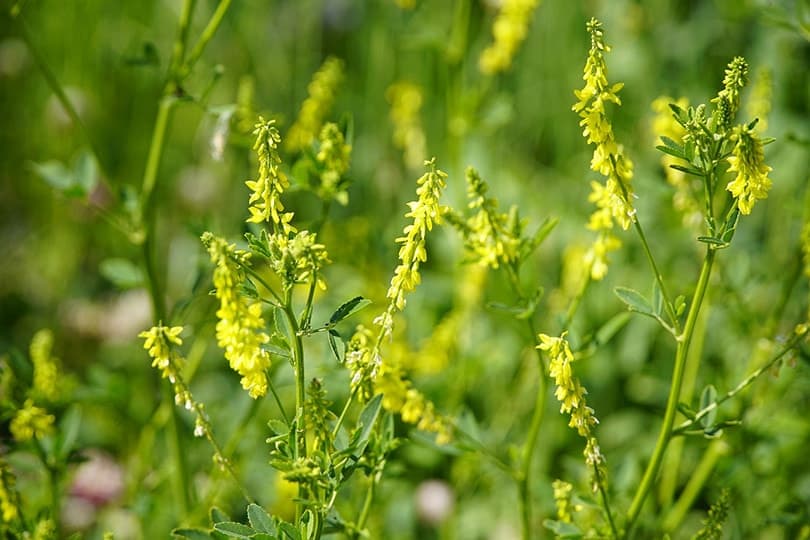What a peaceful sight to watch cows grazing in a pasture. Of course, there’s plenty for them to eat, with all the grasses and summer wildflowers growing everywhere. You may notice another common species among the alfalfa and vetch growing in the fields, White Sweet Clover or other varieties of the genus Trifolium. You may wonder whether it’s all right for cows to eat all these different plants.
As far as clovers are concerned, cows should not eat clover.

Clover Species

We mentioned that there are several species of clovers. The main varieties in the United States are in the Trifolium and Melilotus genera. The distinction is significant because of the possible health risks for cows eating these plants. Both groups are members of the pea or legume family. The ones you see in your backyard or the pasture were introduced from Europe. They both occur throughout the continent.
You can identify them by their clusters or spikes of fragrant flowers. That’s one reason why bees pollinate them because of their sweet nectar. It’s also something that makes them palatable to cows. It’s also why early settlers used them to flavor hot drinks or use the leaves for salads. However, just because people can eat something doesn’t mean the same applies to animals.
White Sweet Clover

White Sweet Clover resembles the garden varieties and has a pleasant scent, too. However, the effects of a cow eating them are different. The problem occurs if the animal eats the spoiled plants. That can easily happen if the clover is bundled with other hay varieties and isn’t dried properly. This can cause toxins to flourish, and hence, the consequences of livestock eating the affected hay are grave.
A cow eating spoiled White Sweet Clover can develop a fatal hemorrhagic disease. Blood vessels in the animal’s body burst and cause internal bleeding. The reason is that the clovers contain coumarins. You may recognize the chemical for its use as a medicine to reduce the risk of clots in humans. It goes by the name warfarin or Coumadin. Ironically, it’s also the active ingredient in rodenticides, such as d-Con.
Cows affected by the spoiled hay will become lame. Treatment includes vitamin K to support normal blood clotting. Whole blood transfusions are often necessary to remove the toxins from the animal’s system. To clarify, it’s not that the clover plants are harmful for a cow to eat if they are growing wild in the pasture. It’s the spoiled hay that is the problem.
However, damp environmental conditions can also cause dead or dying plants to develop these toxins. Experts recommend a mix of feed types or alfalfa. They also urge farmers not to offer pregnant cows clover for 4 weeks before calving.
The Problem With Clovers
Clovers pose different issues, depending on the species. The genus Trifolium includes common plants, such as the pink Alsike Clover and the larger Buffalo Clover. If a cow eats too many of them, they may become sensitive to ultraviolet radiation. It’s a condition called photosensitization, which is not the same as sunburn. Let us explain.
The effects of photosensitization and sunburn will look similar, although the reason behind them isn’t the same. Sunlight speeds up the reaction of the former. Left untreated, the condition can worsen and leave the animal susceptible to secondary bacterial infections.
Photosensitization occurs when a cow eats various clovers. However, it can also happen if the animal comes in contact with it, such as lying in a field of them. Liver damage is another negative effect of chemicals in the clover accumulating in the cow’s body, something called type III photosensitization. The skin lesions are easily treatable. The latter is not.


Final Thoughts
Clovers are attractive plants, although you may not want them in your lawn. As far as cattle are concerned, it’s best to practice caution with free-ranging animals. It’s difficult to know what they may find as they forage. You’re also less likely to spot a problem before it becomes serious. The best advice we can offer is to monitor your livestock’s feeding and provide them with a high-quality diet.
We can also learn a lesson from Paracelsus, the Father of Toxicology, who once said, “The dose makes the poison.” Or in this case, the amount of clover that a cow eats.
Featured Image Credit: jeonsango, Pixabay
